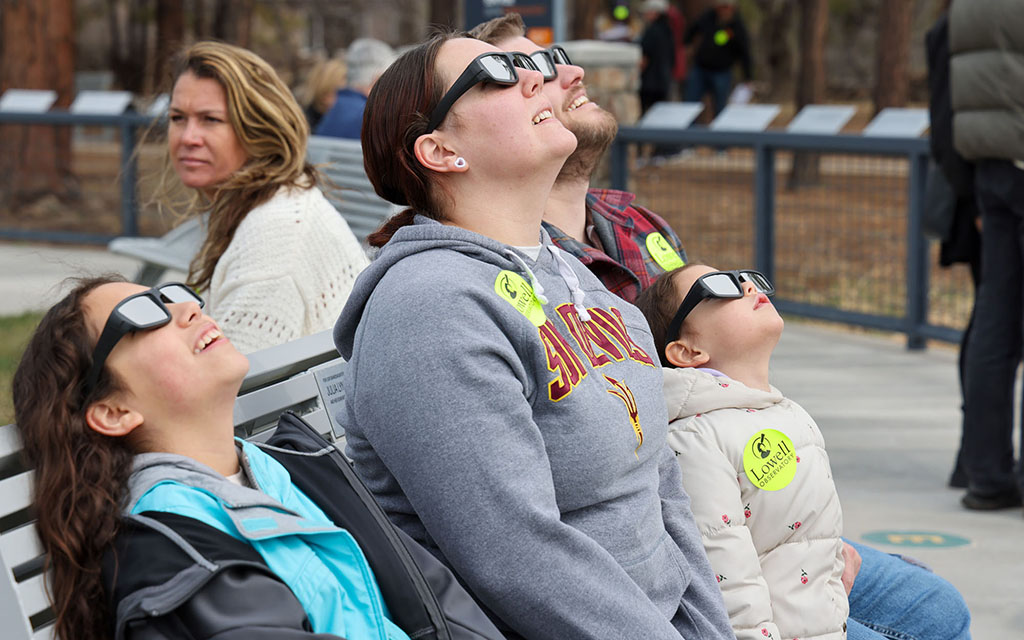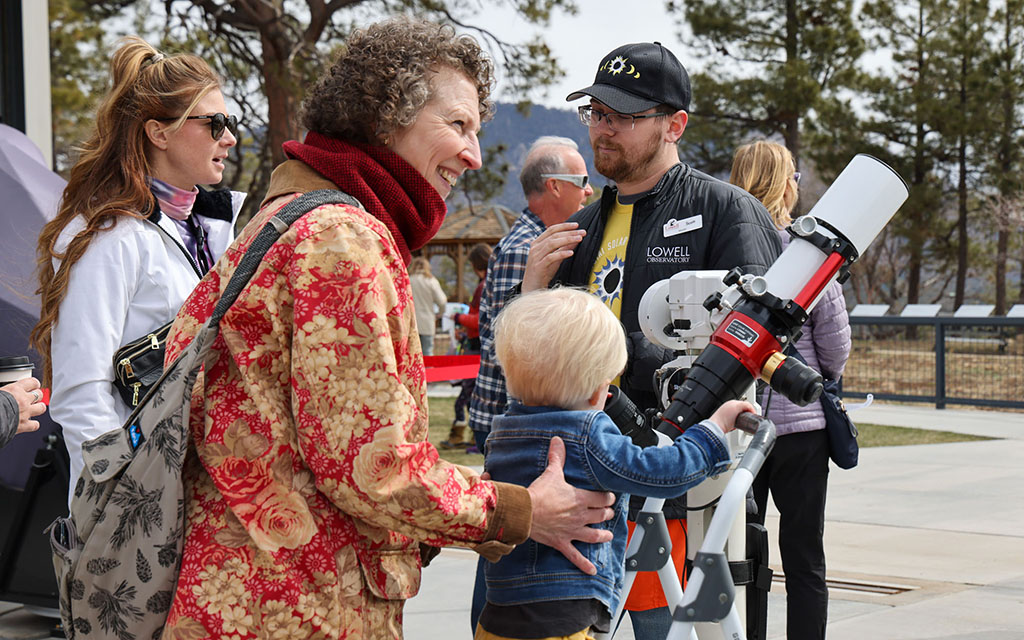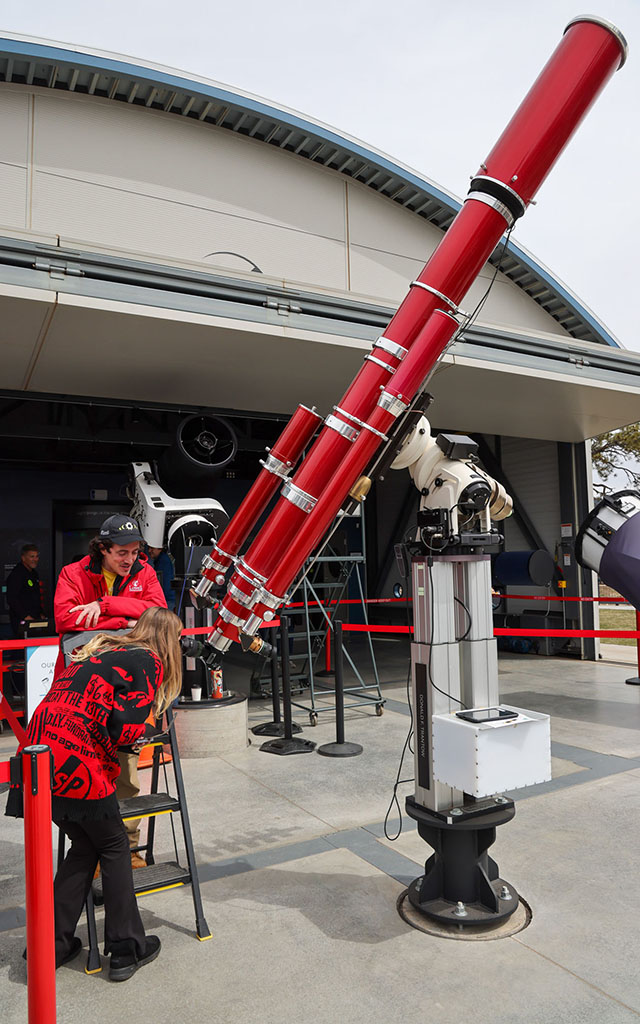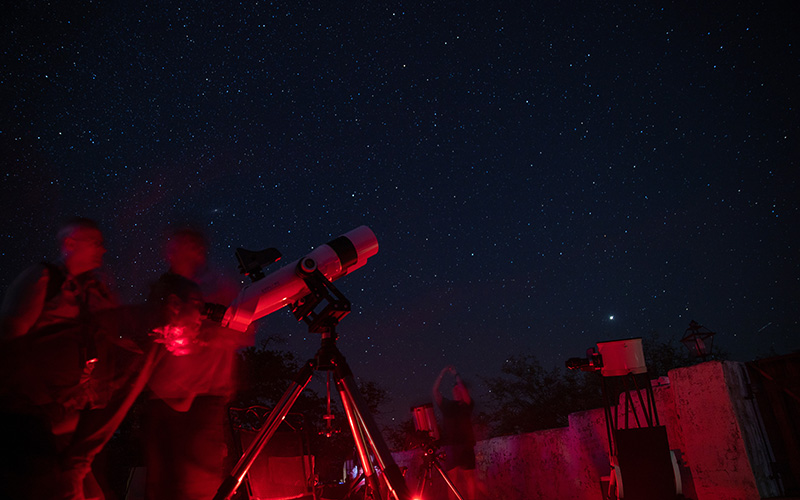
From left, Amelia, Megan, Ariel and Jarrot Kronenwetter wear protective glasses as they look at the eclipse Monday outside the Lowell Observatory in Flagstaff. (Photo by Crystal Aguilar/Cronkite News)

Todd Gonzales, education manager at the Lowell Observatory, shows visitors how they can use the holes in an ordinary colander to track the progress of an eclipse by following its shadow on a piece of paper. (Photo by Crystal Aguilar/Cronkite News)

Visitors line up for the chance to look at the eclipse through one of the telescopes set up at Lowell Observatory just for the celestial event. (Photo by Crystal Aguilar/Cronkite News)

Theresa Coleman holds her grandson Blake to look at the solar eclipse Monday through a telescope at Lowell Observatory. Even though he’s only 2, this was Blake’s second eclipse viewing. (Photo by Crystal Aguilar/Cronkite News)
FLAGSTAFF – The weather was chilly and the skies were partly cloudy, but that did not dampen the enthusiasm of the hundreds who came to Lowell Observatory to watch the last solar eclipse in the continental U.S. for the next 20 years.
The observatory was not in the path of totality for Monday’s so-called “Great American Eclipse,” which cast a shadow from Texas through New England, but sky-watchers in Arizona were able to see about two-thirds of the sun blocked by the moon at the height of the eclipse.
They ranged from elderly couples to families like the Colemans, a Flagstaff family that brought 2-year-old Blake to experience his second solar eclipse, after he saw one in October that “he talked about for weeks.”
“We saw the eclipse at home and he thought it was very interesting, especially looking at the crescent shapes of light on the ground,” Theresa Coleman, Blake’s grandmother, said of the October event. “We got pictures of it and talked about it ever since.
“He was only 2, so anything that sticks in his mind is worth celebrating,” she said.
That was the idea behind the “Great American Eclipse Party” at the observatory, which featured food trucks and merchandise tables, along with presentations by astronomers and a chance to look at the eclipse through one of a handful of telescopes set up for visitors.

Skye Reed peers through the 8-inch Moonraker Victorian Refractor telescope to see the eclipse from the Lowell Observatory. (Photo by Crystal Aguilar/Cronkite News)
The eclipse moved northeast across Mexico Monday morning with the path of totality in the U.S. – the area where the sun was completely blocked by the moon – carving a path from Texas to Maine before heading to Canada and out to the Atlantic Ocean.
In Arizona, the eclipse began around 10 a.m. and ended around 12:30 p.m., with about 60% of the sun blocked at the peak of the eclipse around 11:20 a.m.
“The cloud coverage wasn’t great,” said Heather Craig, marketing operations coordinator for Lowell Observatory. “I would say it was partial, but luckily it was thin enough to see the eclipse through the veil.”
People could look through one of the observatory’s telescopes set up for the event. Some stood in line for as long as 30 minutes for a chance to view the eclipse through a bright red telescope that appeared to be about 10 feet long.
But not all the equipment was so fancy. People with the proper eye protection could simply tilt their heads back and look at the skies, and one observatory worker showed visitors how to track the progress of the eclipse with ordinary household items.
When the sun came through the clouds, Lowell education manager Todd Gonzales showed attendees how they could use a colander and piece of paper to follow the stages of the eclipse by watching changes in its shadow.
“To see people’s reaction, that they could observe an eclipse with a colander … a lot of the responses were like, ‘Oh my gosh, I have been tracking down glasses all week, and I could have just brought a colander,'” Gonzales said.
Despite the brisk 36-degree weather, visitors maintained an upbeat but relaxed energy throughout the eclipse.
Astronomers were on hand to explain eclipses for those gathered to watch. Lowell public program manager Juan Ruiz explained that eclipses are possible due to the fact that the size of the moon and the distance of the sun align for the “perfect” circumstances.
“The fact that eclipses can even happen is crazy to think about,” Ruiz said. “The sun is 400 times further than the moon, and 400 times bigger, so that is the reason why the sun and moon look the exact same size in the sky to us. If those numbers were off even a little bit we wouldn’t have eclipses.”
The next total solar eclipse will be on Aug. 12, 2026, but will only be visible in the Arctic, eastern Greenland, Iceland and northern Spain. The next North American total eclipse will be March 30, 2033, but will only be visible in Alaska.
The next best shot for eclipse fans who don’t want to travel will be in 2044, when it falls across Montana, the Dakotas, parts of Canada and Greenland, followed by a U.S. coast-to-coast eclipse in 2045.
Chances are Oliver will be ready.
Oliver, whose parents declined to give his last name, said he was already excited to be out of school Monday, and that excitement went sky-high for the space-loving kid when he found out he would be witnessing his first solar eclipse.
“My favorite part of looking around is looking in the telescopes,” he said. “I like to see space, I like all the stars.”


